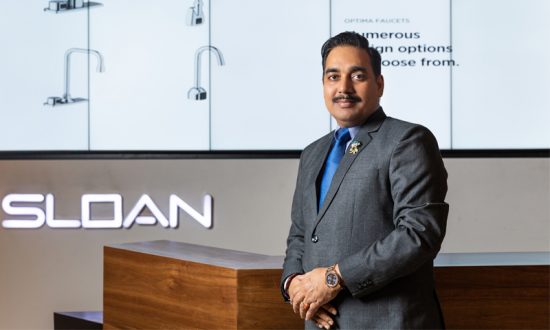A seasoned professional with a career spanning over two decades in the building materials industry, Anup Kumar Tripathi is the General Manager, Sloan India Private Limited. Anup joined Sloan India in 2016 and leads India’s business operations to strengthen Sloan’s brand while growing business across the country. He has implemented some of the most prestigious projects for Sloan across the country. These projects include Infosys Campus, Bangalore; World Bank, New Delhi; US Embassy, New Delhi; Taj Coromandel, Chennai; KIA Motors showrooms, Pan-India; Lokhandwala International School, Mumbai; and many others. Prior to joining Sloan India, Anup was associated with some of the premium faucet brands in India such as Tropical Industries International, Hindware, and Jaquar and Co. An alumnus of Agra University and Poorvanchal University, he holds degrees in Mechanical Engineering and Business Management.
Public or commercial washrooms are used by thousands of people daily. Driven by high usage, proper hygiene and regular maintenance have always been critical in such areas. But the COVID-19 pandemic has triggered greater sensitivity and awareness about ensuring the utmost hygiene in commercial restrooms. In a pandemic-stricken world, hand hygiene practices have assumed immense significance to minimise or eliminate potential health hazards in confined public places.
Quite naturally, surface areas in public washrooms can be live reservoirs of bacteria, viruses and other harmful pathogens. Moreover, whenever anybody sneezes or coughs in such a closed environment, respiratory particles can land on exposed surfaces. These can then be transmitted to other users, more so in washrooms where manual fixtures are touched repeatedly.
Smart Fixtures
Given this backdrop, touch-free washroom fittings and fixtures have assumed critical importance in preventing cross-contamination and the faster spread of COVID-19 and other dangerous viruses. As a result, both manufacturers of restroom products and owners of premises are moving towards touch-free flush-meters, faucets, hand dryers, sinks, soap dispensers and allied items.
The focus on confined spaces such as washrooms dealing with sanitation and wastewater systems is for apparent reasons. Indeed, considering the health and hygiene ramifications of the coronavirus, in November 2020, the International Water Association and the Toilet Board Coalition released a White Paper titled, Improving Public Health through Smart Sanitation and Digital Water.
The paper highlighted that lives could be saved and disease spread prevented by digitalising sanitation and wastewater systems. It noted that sanitation and wastewater-linked epidemiology had emerged as one of the earliest and accurate reflections of a city’s populations’ infection rate. Smart technology such as biosensors, in particular, have been developed for varied uses in sanitation infrastructure. This ranges from garnering data about certain health outcomes such as the quantification of drug usage or screening for infectious ailments to checking individual health-related behaviour patterns, including tracking toilet usage. By combining diagnostic data along with toilet usage and environmental data, it is possible to decipher deeper insights into the behaviour and health of communities.
Consequently, the paper advocates collaborative sanitation and water ecosystems where such facility operators work in tandem with municipal authorities and governments in mapping systems and usage data. Thereby, this can create a new value paradigm, shifting the focus from reactive disease outbreak mechanisms to a proactive, preventive mode. On micro and macro scales, smart sanitation systems can emerge as an opportunity for enterprises to ensure employees a safe, hygienic and healthy work environment.
Promoting Water Security
Another extremely vital element necessitates digitalising sanitation and wastewater systems in India and globally – the universal water crisis, particularly because of pandemic-induced hygiene protocols. Going by statistics, while 600 million in India experience water shortages annually, almost 200,000 people succumb because of inadequate water supplies. Moreover, 163 million don’t have access to safe and clean water while more than 140,000 children die due to diarrhoea each year.
To address such situations, digitalisation of water and the use of smart water meters can help in saving large amounts of the liquid gold presently lost due to inefficient systems, leakage and wastage. The importance of smart technology in conserving water is especially imperative during the pandemic.
Hygiene, handwashing and sanitisation protocols under COVID-19 guidelines make each person use between 20 and 40 litres of water to wash their hands at least 10 times daily. In other words, a family of five ends up using between 100 and 200 litres of water every day only in washing hands. In turn, this generates an additional 200 litres of wastewater daily, constituting 20% to 25% increase in water demand and generation of wastewater arising from human settlements.
With many cities already suffering severe water shortages, the pandemic-induced norms are exacerbating the water crisis. The demand-supply gap in water then results in more exploitation of groundwater reserves, raising the untreated volume of wastewater, which worsens in summers when water sources dry out faster.
The gravity of the impending water crisis is crystal clear. In addressing such serious water security issues, developed nations are accelerating the deployment of digital means. Therefore, there is a shift from an assumption-based water management system to a more data-driven approach.
Such smart systems based on data-driven models help in integrating and optimising the use of water via smart sensors, pumps, valves and suchlike. Since smart devices can share data and “talk” to each other, real-time information is accessed and relayed over the cloud. Water utilities can then take corrective action in real-time, reducing expected risks and predicting demand-supply variations as per the shared data on their digital systems.
As an emerging country, India focuses on building smart cities to improve its liveability index, a transition to smart water meters and the digitalisation of water systems remains the need of the hour. This will hold relevance both for the pandemic and post-pandemic periods.






